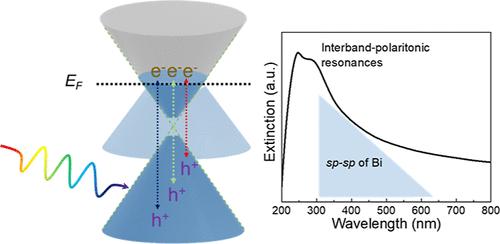当前位置:
X-MOL 学术
›
J. Phys. Chem. C
›
论文详情
Our official English website, www.x-mol.net, welcomes your
feedback! (Note: you will need to create a separate account there.)
Deciphering the Photocatalysis Mechanism of Semimetallic Bismuth Nanoparticles
The Journal of Physical Chemistry C ( IF 3.3 ) Pub Date : 2024-11-16 , DOI: 10.1021/acs.jpcc.4c06136 Lauren M. Hoffman, Delaney J. Hennes, Pin Lyu
The Journal of Physical Chemistry C ( IF 3.3 ) Pub Date : 2024-11-16 , DOI: 10.1021/acs.jpcc.4c06136 Lauren M. Hoffman, Delaney J. Hennes, Pin Lyu

|
Metallic nanoparticle photocatalysts have been developed in various catalytic systems over the past few decades, including diverse noble and non-noble metals with plasmonic properties. The hot-carrier-induced mechanism is one of the most appealing pathways as it can provide energetic electrons or holes for driving thermodynamically unfavorable reactions or increasing the reaction rate. In this work, we evaluate the photocatalytic performance of semimetallic bismuth nanoparticles and offer detailed mechanistic interpretations in terms of hot carriers and interband transitions. The photocatalyzed nitrophenol reduction with sodium borohydride serves as a model reaction, and a wavelength-dependent study reveals the contribution of hot carriers. It is demonstrated that light irradiation under shorter wavelengths could produce deeper hot holes in bismuth nanoparticles, which can be quenched more effectively by hole scavengers, thus facilitating the electron-transfer process and resulting in larger apparent reaction rate constants. The observed photocatalysis enhancement accounts for the unique band structure with an extremely small band gap and exclusive interband absorption in the visible region. This proof-of-concept work offers a different perspective on the photocatalysis mechanism of bismuth nanoparticles and could help us better understand the role of hot carriers involved in photocatalysis, especially with interband transitions.
中文翻译:

破译半金属铋纳米颗粒的光催化机理
在过去的几十年里,金属纳米粒子光催化剂已经在各种催化系统中开发出来,包括具有等离激元特性的各种贵金属和非贵金属。热载流子诱导机制是最吸引人的途径之一,因为它可以提供高能电子或空穴来驱动热力学上的不利反应或提高反应速率。在这项工作中,我们评估了半金属铋纳米颗粒的光催化性能,并根据热载流子和带间转变提供了详细的机理解释。用硼氢化钠进行光催化的硝基苯酚还原用作模型反应,波长依赖性研究揭示了热载流子的贡献。结果表明,较短波长下的光照射可以在铋纳米颗粒中产生更深的热空穴,空穴清除剂可以更有效地猝灭热空穴,从而促进电子转移过程并产生更大的表观反应速率常数。观察到的光催化增强解释了独特的能带结构,具有极小的带隙和可见光区域的独家带间吸收。这项概念验证工作为铋纳米颗粒的光催化机制提供了不同的视角,可以帮助我们更好地了解参与光催化的热载流子的作用,尤其是带间跃迁。
更新日期:2024-11-16
中文翻译:

破译半金属铋纳米颗粒的光催化机理
在过去的几十年里,金属纳米粒子光催化剂已经在各种催化系统中开发出来,包括具有等离激元特性的各种贵金属和非贵金属。热载流子诱导机制是最吸引人的途径之一,因为它可以提供高能电子或空穴来驱动热力学上的不利反应或提高反应速率。在这项工作中,我们评估了半金属铋纳米颗粒的光催化性能,并根据热载流子和带间转变提供了详细的机理解释。用硼氢化钠进行光催化的硝基苯酚还原用作模型反应,波长依赖性研究揭示了热载流子的贡献。结果表明,较短波长下的光照射可以在铋纳米颗粒中产生更深的热空穴,空穴清除剂可以更有效地猝灭热空穴,从而促进电子转移过程并产生更大的表观反应速率常数。观察到的光催化增强解释了独特的能带结构,具有极小的带隙和可见光区域的独家带间吸收。这项概念验证工作为铋纳米颗粒的光催化机制提供了不同的视角,可以帮助我们更好地了解参与光催化的热载流子的作用,尤其是带间跃迁。


















































 京公网安备 11010802027423号
京公网安备 11010802027423号